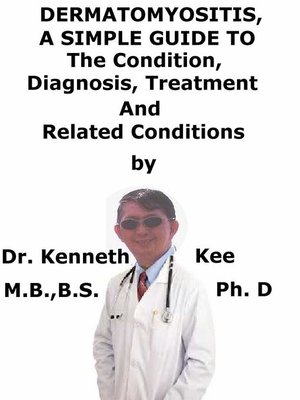Dermatomyositis, a Simple Guide to the Condition, Diagnosis, Treatment and Related Conditions
ebook
By Kenneth Kee

Sign up to save your library
With an OverDrive account, you can save your favorite libraries for at-a-glance information about availability. Find out more about OverDrive accounts.
Find this title in Libby, the library reading app by OverDrive.



Search for a digital library with this title
Title found at these libraries:
| Library Name | Distance |
|---|---|
| Loading... |
Dermatomyositis is a medical muscle disorder characterized by inflammation and a skin rash.
It is a form of inflammatory myopathy (muscle disease).
Dermatomyositis is connective tissue disease characterized by inflammation of muscles.
Although dermatomyositis involves the skin and muscles, it may also involve other parts of the body such as joints, esophagus, lungs and heart.
It is possible to divide the dermatomyositis into three basic subgroups according to cause:
1. Idiopathic dermatomyositis in adults.
2. Childhood dermatomyositis or myositis with necrotizing vasculitis.
3. Dermatomyositis linked with malignancy.
It may be due to a viral infection involving the muscles or a disorder with the body's immune system.
It can also sometimes occur in patients who have cancer of the lung, abdomen, or other body organ.
Any person can develop dermatomyositis but it frequently happens in adults aged 40-60.
Dermatomyositis affects children aged 5-15 and as well as adults.
There is:
1. Sudden muscle weakness, stiffness, or soreness
2. Purple-red skin rash
3. Purple or violet colored upper eyelids
Autoantibodies are present:
a. Antinuclear antibody (ANA) finding is positive in patients with dermatomyositis.
b. Anti-Mi-2 antibodies are particular to dermatomyositis
Muscle biopsy can be diagnostic.
Early starting of medical treatment is important.
The disease is treated with anti-inflammatory medicines called corticosteroids and drugs that suppress the immune system.
Intravenous immunoglobulin is proper treatment in patients with resistant dermatomyositis or aggressive disease
Other treatments are antimalarial agents and immunomodulatory therapies
1 in 5 people may recover and the symptoms disappear completely.
Doctors have reported several such cases, especially in children.
Most cases are able to survive but may develop residual disability and muscle weakness.
TABLE OF CONTENT
Introduction
Chapter 1 Dermatomyositis
Chapter 2 Causes
Chapter 3 Symptoms
Chapter 4 Diagnosis
Chapter 5 Treatment
Chapter 6 Prognosis
Chapter 7 Polymyositis
Chapter 8 Systemic Lupus Erythematosus
Epilogue







